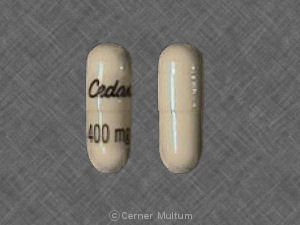Ceftibuten Dosage
Applies to the following strengths: 400 mg; 90 mg/5 mL; 180 mg/5 mL
Usual Adult Dose for:
Usual Pediatric Dose for:
Additional dosage information:
Usual Adult Dose for Otitis Media
400 mg orally once a day for 10 days
Uses:
- For the treatment of acute bacterial exacerbations of chronic bronchitis due to Haemophilus influenzae (including beta-lactamase-producing strains), Moraxella catarrhalis (including beta-lactamase-producing strains), or Streptococcus pneumoniae (penicillin-susceptible strains only)
- For the treatment of acute bacterial otitis media due to H influenzae (including beta-lactamase-producing strains), M catarrhalis (including beta-lactamase-producing strains), or S pyogenes
- For the treatment of pharyngitis and tonsillitis due to S pyogenes
Usual Adult Dose for Tonsillitis/Pharyngitis
400 mg orally once a day for 10 days
Uses:
- For the treatment of acute bacterial exacerbations of chronic bronchitis due to Haemophilus influenzae (including beta-lactamase-producing strains), Moraxella catarrhalis (including beta-lactamase-producing strains), or Streptococcus pneumoniae (penicillin-susceptible strains only)
- For the treatment of acute bacterial otitis media due to H influenzae (including beta-lactamase-producing strains), M catarrhalis (including beta-lactamase-producing strains), or S pyogenes
- For the treatment of pharyngitis and tonsillitis due to S pyogenes
Usual Adult Dose for Bronchitis
400 mg orally once a day for 10 days
Uses:
- For the treatment of acute bacterial exacerbations of chronic bronchitis due to Haemophilus influenzae (including beta-lactamase-producing strains), Moraxella catarrhalis (including beta-lactamase-producing strains), or Streptococcus pneumoniae (penicillin-susceptible strains only)
- For the treatment of acute bacterial otitis media due to H influenzae (including beta-lactamase-producing strains), M catarrhalis (including beta-lactamase-producing strains), or S pyogenes
- For the treatment of pharyngitis and tonsillitis due to S pyogenes
Usual Pediatric Dose for Bronchitis
12 years or older: 400 mg orally once a day for 10 days
Use: For the treatment of acute bacterial exacerbations of chronic bronchitis due to H influenzae (including beta-lactamase-producing strains), M catarrhalis (including beta-lactamase-producing strains), or S pneumoniae (penicillin-susceptible strains only)
Usual Pediatric Dose for Otitis Media
6 months to 11 years: 9 mg/kg orally once a day
- Maximum dose: 400 mg/day
Duration of therapy: 10 days
Uses:
- For the treatment of acute bacterial otitis media due to H influenzae (including beta-lactamase-producing strains), M catarrhalis (including beta-lactamase-producing strains), or S pyogenes
- For the treatment of pharyngitis and tonsillitis due to S pyogenes
Usual Pediatric Dose for Tonsillitis/Pharyngitis
6 months to 11 years: 9 mg/kg orally once a day
- Maximum dose: 400 mg/day
Duration of therapy: 10 days
Uses:
- For the treatment of acute bacterial otitis media due to H influenzae (including beta-lactamase-producing strains), M catarrhalis (including beta-lactamase-producing strains), or S pyogenes
- For the treatment of pharyngitis and tonsillitis due to S pyogenes
Renal Dose Adjustments
CrCl 30 to 49 mL/min:
- Adult patients (12 years or older): 200 mg orally every 24 hours
- Pediatric patients (6 months to 11 years): 4.5 mg/kg orally every 24 hours
- Maximum dose: 200 mg/day
CrCl 5 to 29 mL/min:
- Adult patients (12 years or older): 100 mg orally every 24 hours
- Pediatric patients (6 months to 11 years): 2.25 mg/kg orally every 24 hours
- Maximum dose: 100 mg/day
Liver Dose Adjustments
Data not available
Precautions
CONTRAINDICATIONS:
Known allergy to cephalosporin antibiotics
Safety and efficacy have not been established in patients younger than 6 months.
Consult WARNINGS section for additional precautions.
Dialysis
Hemodialysis (2 or 3 times a week):
- Adult patients (12 years or older): 400 mg orally at the end of each hemodialysis session
- Pediatric patients (6 months to 11 years): 9 mg/kg orally at the end of each hemodialysis session
- Maximum dose: 400 mg/dose
Peritoneal dialysis: Data not available
Comments:
- Hemodialysis removed 65% of the drug from the blood in 2 to 4 hours.
- Dialysis patients should be monitored carefully.
Other Comments
Administration advice:
- Administer the oral suspension at least 2 hours before or 1 hour after a meal.
- Shake the oral suspension well before each use.
- Use empirically for acute otitis media only after administering adequate coverage against S pneumoniae.
Storage requirements:
- Capsules and oral suspension (before reconstitution): Store between 2C and 25C (36F and 77F).
- Oral suspension (after reconstitution): Store in the refrigerator between 2C and 8C (36F and 46F) and keep tightly closed; discard after 14 days.
Reconstitution/preparation techniques:
- Oral suspension: The manufacturer product information should be consulted.
General:
- This drug is recommended for mild to moderate infections due to susceptible strains of the designated microorganisms in the specified indications.
- In acute bacterial exacerbations of chronic bronchitis studies, clinical efficacy of this drug was 22% less than control when M catarrhalis was isolated from infected sputum at baseline.
- Although empirical use of this drug was equal to comparators when treating clinically and/or microbiologically documented acute otitis media, its efficacy against S pneumoniae was 23% less than control.
- Only IM penicillin was shown effective to prevent rheumatic fever; this drug was generally effective in eradicating S pyogenes from the oropharynx but data showing efficacy for prophylaxis of subsequent rheumatic fever are not available.
- The oral suspension contains 1 g sucrose/5 mL.
Monitoring:
- Renal: Renal function in elderly patients
Patient advice:
- Avoid missing doses and complete the entire course of therapy.
More about ceftibuten
- Check interactions
- Compare alternatives
- Reviews (3)
- Side effects
- During pregnancy
- Drug class: third generation cephalosporins
- Breastfeeding
Patient resources
Other brands
Professional resources
Related treatment guides
See also:
Further information
Always consult your healthcare provider to ensure the information displayed on this page applies to your personal circumstances.


